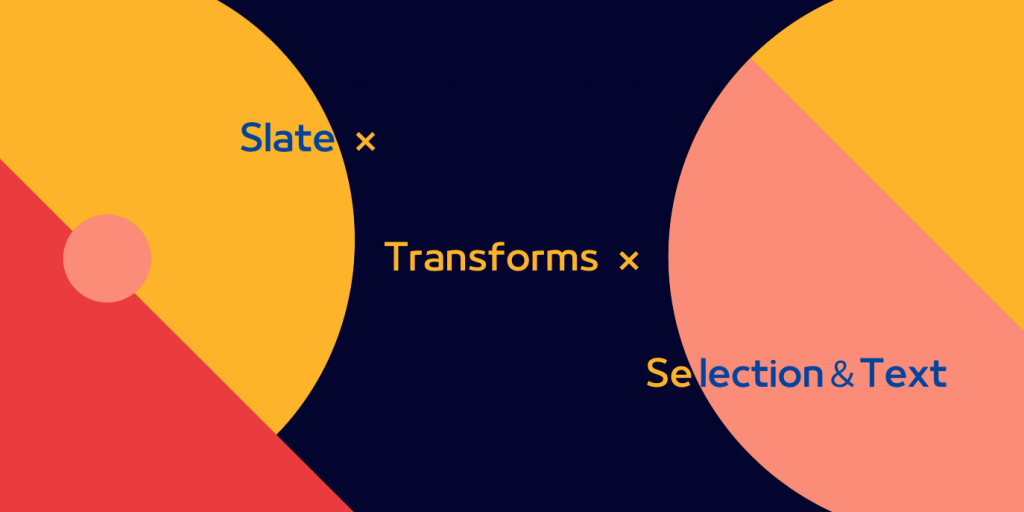
上一篇我們統整了 NodeTransforms 裡各個 methods 的用法以及參數介紹, 傳送門 在此~
這一篇同樣會以 reference 的形式統整 SelectionTransforms 以及 TextTransforms 的功用以及傳入參數的用途。
collapse用途:收合編輯器 selection
參數:
editor: Editor
options: CollapseOptions
options :
interface CollapseOptions {
edge?: 'anchor' | 'focus' | 'start' | 'end'
}
edge
決定 selection 要往哪一個 Point 收合:
'anchor'
往 selection 的 anchor point 收合
'focus'
往 selection 的 focus point 收合
'start'
會搭配 Range.edges 以及 Range.isBackward method 判斷 selection 是否為『反向的』並得出真正的起始、結束位置
並往相對起始的 point 收合
'end'
會搭配 Range.edges 以及 Range.isBackward method 判斷 selection 是否為『反向的』並得出真正的起始、結束位置
並往相對結束的 point 收合
deselectselection valueeditor: Editor
裡頭的程式碼很基本,就是直接呼叫 'set_selection' Operation
/**
* Unset the selection.
*/
deselect(editor: Editor): void {
const { selection } = editor
if (selection) {
editor.apply({
type: 'set_selection',
properties: selection,
newProperties: null,
})
}
},
move用途:向前或向後移動 selection 裡頭的 points 。
參數:
editor: Editor
options: MoveOptions
options :
interface MoveOptions {
distance?: number
unit?: 'offset' | 'character' | 'word' | 'line'
reverse?: boolean
edge?: 'anchor' | 'focus' | 'start' | 'end'
}
distance
搭配 unit (單位)決定一次要移動的實際距離
unit
移動的單位,分為 'offset' 、 'character' 、 'word' 、 'line' 。關於不同的單位實作的細節被集中在 Editor.positions 裡,包含它的演算法也都被作者 comment 在 method 裡。因為太過細節了這邊就不詳細解說,再請有興趣的讀者自行上前查看。
reverse
決定 points 移動的方向:
reverse: true :向前移動reverse: false :向後移動edge
決定要移動的 selection point ,分為:
'anchor'
只移動 anchor point
'focus'
只移動 focus point
'start'
會搭配 Range.isBackward method 判斷 selection 是否為『反向的』,將相對起始的 point ( 'anchor' | 'focus' ) assign 給 edge
'end'
會搭配 Range.isBackward method 判斷 selection 是否為『反向的』,將相對結束的 point ( 'anchor' | 'focus' ) assign 給 edge
edge 的預設值為 null ,這會同時移動 anchor 與 focus point
selectselection valueeditor: Editor
target: Location
這裡頭的程式碼也很基本:
包含確保的 target 為 Range type
target = Editor.range(editor, target)
更新 selection 屬性
const { selection } = editor
if (selection) {
Transforms.setSelection(editor, target)
return
}
拋出例外狀況
if (!Range.isRange(target)) {
throw new Error(
`When setting the selection and the current selection is \`null\` you must provide at least an \`anchor\` and \`focus\`, but you passed: ${JSON.stringify(
target
)}`
)
}
執行 Operation
editor.apply({
type: 'set_selection',
properties: selection,
newProperties: target,
})
setPoint用途:對編輯器 selection 的其中一個 Point 設定新的 props 屬性
參數:
editor: Editor
props: Partial<Point>
options: SetPointOptions
options :
interface SetPointOptions {
edge?: 'anchor' | 'focus' | 'start' | 'end'
}
edge
決定要將 props 取得的屬性設定於 selection 的哪一個 Point
'anchor'
將 props 設定於 anchor point 上
'focus'
將 props 設定於 focus point 上
'start'
會搭配 Range.edges 以及 Range.isBackward method 判斷 selection 是否為『反向的』並得出真正的起始、結束位置
並將 props 設定於相對起始的 point 上
'end'
會搭配 Range.edges 以及 Range.isBackward method 判斷 selection 是否為『反向的』並得出真正的起始、結束位置。
並將 props 設定於相對結束的 point 上。
setSelectionprops 屬性在編輯器的 selection 上editor: Editor
props: Partial<Range>
除了設定 custom 屬性之外,它也同時確保不會將 selection 裡的 anchor 或 focus point 設為 null
for (const k in props) {
if (
(k === 'anchor' &&
props.anchor != null &&
!Point.equals(props.anchor, selection.anchor)) ||
(k === 'focus' &&
props.focus != null &&
!Point.equals(props.focus, selection.focus)) ||
(k !== 'anchor' && k !== 'focus' && props[k] !== selection[k])
) {
oldProps[k] = selection[k]
newProps[k] = props[k]
}
}
delete用途:移除編輯器內的文字內容
參數:
editor: Editor
options: DeleteOptions
options :
interface DeleteOptions {
at?: Location
distance?: number
unit?: 'character' | 'word' | 'line' | 'block'
reverse?: boolean
hanging?: boolean
voids?: boolean
}
at
欲刪除的文字內容於編輯器裡的位置,分為三種刪除情形:
at 傳入一組 Path → 將整個節點刪除at 傳入一組 Range → 將 Range 集合的文字內容刪除at 傳入一個 Point → 搭配 distance 與 unit 決定要從該 Point 向前刪除多少文字內容distance
搭配 unit (單位)決定一次要移動的實際距離
unit
移動的單位,分為 'offset' 、 'character' 、 'word' 、 'line' 。關於不同的單位實作的細節被集中在 Editor.positions 裡,包含它的演算法也都被作者 comment 在 method 裡。因為太過細節了這邊就不詳細解說,再請有興趣的讀者自行上前查看。
reverse
如果傳入的 at 為 Point 的話, reverse 會決定節點的刪除方向
reverse: true :向前刪除reverse: false :向後刪除hanging
這個 value 會決定 Range 是否要另外修正為 unhanging type 。
hanging 在 Slate 裡頭的意思代表『這段 Range 涵蓋到了不存在的節點』。
我們假設目前的 Slate Document 如下:
[{text: 'one '}, {text: 'two', bold: true}, {text: ' three'}]
這時使用者看到的顯示方式應該如下:
one two three
假設使用者選取了 "two" ,此時的 selection 會有幾種 anchor 與 focus points 的可能性出現
// 1 -- no hanging
{
anchor: { path: [1], offset: 0 },
focus: { path: [1], offset: 3 }
}
// 2 -- anchor hanging
{
anchor: { path: [0], offset: 4 },
focus: { path: [1], offset: 3 }
}
// 3 -- focus hanging
{
anchor: { path: [1], offset: 0 },
focus: { path: [2], offset: 0 }
}
// 4 -- both hanging
{
anchor: { path: [0], offset: 4 },
focus: { path: [2], offset: 0 }
}
當我們傳入 hanging: false 時, Slate 就會將這組 Range 傳入 Editor.unhangRange method 裡確保 Range 維持在第一種情形。
voids
決定在這個 Transform method 有呼叫到的所有操作行為中,是否要略過或避開 void nodes 的出現 。
這個 method 也有處理跨節點相關的情境,筆者這邊暫且不多做介紹,未來有機會再追加補充。
insertFragment用途:插入一組 Fragment 進指定的 at Location 裡
參數:
editor: Editor
fragment: Node[]
options: InsertFragmentOptions
options :
interface InsertFragmentOptions {
at?: Location
hanging?: boolean
voids?: boolean
}
at
要插入 Fragment nodes 的位置,分為三種插入情形:
at 傳入一組 Path → 將 Fragments 插入進節點的開頭位置at 傳入一組 Range → 將 Range 集合的文字內容移除後插入 Fragmentsat 傳入一個 Point → 直接將 Fragments 插入進該 Point 之後hanging
如果傳入的 at 為 Range type ,則這個 value 會決定 Range 是否要另外修正為 unhanging type 。
詳細的解釋請參照上方的 DeleteOptions
voids
決定在這個 Transform method 有呼叫到的所有操作行為中,是否要略過或避開 void nodes 的出現 。
insertText用途:插入一段文字字串進編輯器裡
參數:
editor: Editor
text: string
options: InsertTextOptions
options :
interface InsertTextoptions {
at?: Location
voids?: boolean
}
at
欲將文字插入於編輯器中的位置,分為三種輸入情形:
at 傳入一組 Path → 將整個節點的文字內容修改為新輸入的內容at 傳入一組 Range → 將 Range 集合的文字內容修改為新輸入的內容at 傳入一個 Point → 直接將新輸入的內容插入進該 Point 之後void
一組布林值,決定文字插入的節點所屬的 branch 的上層祖先節點能否有 void node 存在。
